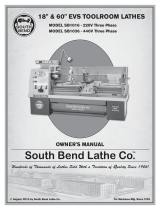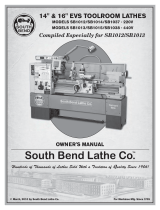Page is loading ...

User Bulletin Number 48
Synergy® Peptide Synthesizer
Jaws Seals and Gaskets
March 1995 (updated October 2001)
SUBJECT: Maintaining and Changing Synergy Jaw Seals and Gaskets
Jaw seals (P/N 004183) and gaskets (P/N 004498) on the Synergy® Peptide
Synthesizer must be in good condition for optimum instrument performance. Worn
seals or gaskets, dirt, or contamination can cause leaks. If the Synergy controller
detects a leak at the jaws while pressure testing the AAC, synthesis stops.
Occasional inspection of the jaw seals and gasket helps avoid these problems.
Inspect these parts every month for signs of wear, such as cracks, discoloration, or
deformation. Replace worn parts annually or when defects are detected. If the parts
are not due for replacement and show no indications of wear, you may continue to use
them on the instrument after they have been cleaned.
WARNING Personal Injury Hazard.
The autosampler jaws are operated by a
pneumatic valve under high pressure. Painful injury can occur if the
jaws close on fingers or hands. Before working on the autosampler
assembly, close the main supply valve on top of the external gas tank
and turn off the instrument power.
Routine Cleaning of Jaw Seals and Gaskets
1. Close the main supply valve on top of the external gas tank.
2. Turn off the Synergy power switch.
3. Remove the amino acid column wheel from its position on Synergy.
4. Dip a cotton swab into methanol once and squeeze out excess methanol.
5. Run the cotton swab around both the top and bottom jaw seal and gasket.
If the cotton swab comes away heavily soiled, the seals or gaskets may be worn and need
replacement. Follow the procedure presented in this User Bulletin (page 2) to remove the
upper and lower jaw seals.
6. If the jaw seals and gaskets need no further attention, turn on the Synergy power switch
and open the main supply valve on top of the external gas tank.
7. Verify that the tank regulator setting returns to its original position.

Page 2 of 6 Maintaining and Changing Synergy Jaw Seals and Gaskets
Removal of Jaw
Seals and Gaskets
You can remove jaw seals and gaskets from Synergy with the T-5699 Tool. Figure 1
illustrates how this tool inserts into the jaw seals on Synergy.
Figure 1. T-5699 Tool inserted into a jaw seal
To remove the upper and lower jaw seals from the autosampler jaws
1. Close the main supply valve on top of the external gas tank.
2. Turn off the Synergy power switch.
3. Remove the amino acid column wheel from its position on Synergy.
4. Insert the T-5699 Tool into the lower jaw seal (Figure 2).
You may need to turn the T-5699 Tool until its prongs engage the grooves on the jaw seal
assembly, as illustrated by the dotted lines in Figure 1.

Maintaining and Changing Synergy Jaw Seals and Gaskets Page 3 of 6
Figure 2. Inserting T-5699 Tool into lower jaw
5. Turn the T-5699 Tool counter-clockwise until the lower jaw seal comes free of the
instrument (Figure 3).
You may need to use the small bar that is supplied with the T-5699 Tool to break the seal
free.
Figure 3. Turning the T-5699 Tool to remove the lower jaw seal
6. Insert the T-5699 Tool into the upper jaw seal (Figure 4).
Turn the T-5699 Tool until its prongs engage the grooves on the jaw seal assembly.

Page 4 of 6 Maintaining and Changing Synergy Jaw Seals and Gaskets
7. Turn the T-5699 Tool in the reverse direction used to remove the lower jaw seal. Use the
small bar to help break the seal, if necessary.
Figure 4. Inserting the T-5699 Tool to remove the upper jaw seal
To inspect and clean the jaw seals and gaskets
1. Once the jaw seal is removed from the instrument, gently and carefully pry the gasket from
the end, to avoid damaging either part.
2. Inspect the gaskets and seals for cracks, discoloration, deformation, or other signs of wear.
When necessary, discard worn parts and replace them with new parts to ensure leak-free
operation.
3. Use only methanol to clean the parts and allow them to dry before reassembling the
autosampler jaws.
Figure 5. View of gasket in place on jaw seal

Maintaining and Changing Synergy Jaw Seals and Gaskets Page 5 of 6
To reassemble autosampler jaws
1. Replace clean or new gasket in the lower and upper jaw seals (Figure 5).
Use the rounded protuberance at the end of the T-5699 Tool to seat the gasket into the
seal.
2. Use the T-5699 Tool to replace the upper and lower jaw seals. Turn the tool in the reverse
direction used to remove the seals.
3. Turn on the Synergy power switch and open the main supply valve on top of the external
gas tank.
4. Verify that the tank regulator setting returns to its original position.
5. Perform the Leak Self Test described in Section 4 of the
Synergy User’s Manual
to check
the entire pressure system for leaks.

© Copyright 2001, Applied Biosystems. All rights reserved.
For Research Use Only. Not for use in diagnostic procedures.
ABI PRISM and its design, and Applied Biosystems are registered trademarks of Applera Corporation or its subsidiaries in the U.S. and certain other
countries. ABI is a trademark of Applera Corporation or its subsidiaries in the U.S. and certain other countries.
All other trademarks are the sole property of their respective owners.
Applera Corporation is committed to providing the world’s leading technology and information for life scientists. Applera Corporation consists of the
Applied Biosystems and Celera Genomics businesses..
Stock Number 343825-002
/






